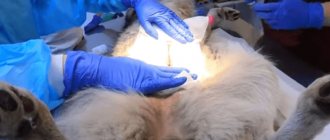The Toy Terrier is a small decorative dog measuring up to 30 cm and weighing up to 3 kg, which will be an ideal four-legged friend for residents of densely populated cities. These small pets get along well in an apartment and do not need long walks; the life expectancy of such pets is from 12 to 15 years.
Toy Terriers are friendly, intelligent, and great with children.
They are also neat, litter box trained quickly, and generally easy to care for.
What is sterilization: all the pros and cons
Any dog owner is faced with the issue of possible sterilization or castration of their pet. This issue does not avoid the owners of toy terriers.
The concept of sterilization is applicable to females (bitches) and is the removal of reproductive organs (ovaries, uterus, fallopian tubes).
The main purpose of sterilization of toy terriers, like any domestic dog, is the prevention of cancer, as well as the prevention of hormonal imbalances that lead to aggressive behavior of the animal, escapes and various diseases.
Another purpose of spaying a Toy Terrier is to prevent unwanted pregnancies in females. When sterilizing a toy terrier, partial removal of the genitals is possible.
For example, only the ovaries or the uterus with one ovary can be removed (to preserve sexual desire and prevent pregnancy).
What is castration and why do it?
The concept of castration is applicable to males (males) and is the surgical removal of the testes. If the owner of the dog does not plan to breed the Toy Terrier breed, then it is considered necessary to neuter the male dogs.
This is done primarily for the purpose of correcting the behavior of the male. Under the influence of excess testosterone (male hormone), the dog sometimes becomes uncontrollable and refuses to follow commands during training ; a tendency to wander and aggression appears .
Castration of toy terriers is also used to prevent various diseases (prostatitis, testicular tumors).
Arguments “AGAINST” castration:
- the existing risk of complications during and after castration surgery for a toy terrier.
- Neutered dogs have an excellent appetite. And if you follow the terrier’s lead, then in a short time the dog will significantly gain weight.
On the Internet, in nurseries, and among toy terrier owners, you can find out reviews about castration of a toy terrier. You will be reassured to know that the dogs that have undergone this procedure have become much more affectionate and obedient, and problems associated with the animal’s gender characteristics have disappeared.
Pros and cons of the procedure for males and females
The positive aspects of castration and sterilization for toy terriers are::
- reducing the risk of cancer in both sexes;
- reducing the risk of hormonal imbalances;
- absence of unpleasant odor in the house, since the pet stops “marking the territory”, reduction in the number of cleanings;
- absence of unwanted pregnancies;
- increasing the life expectancy of a pet;
- improvement of character, behavior, suppression of aggression;
- the pet will not run away from the owner in search of a “groom” or “bride”.
However, the castration/sterilization procedure also has its negative aspects, here they are:
- possible increase in animal weight;
- individual intolerance to the procedure (for example, the presence of heart disease);
- possible complications before and after surgery.
Pros and cons of castration in males, consequences of hysterectomy in females
Sterilization will help prevent the development of many diseases of the genitourinary system, including oncology.
Any medical procedures, especially surgical operations, have their pros and cons in the form of side effects and postoperative consequences. Therefore, before you decide to sterilize your pet, you need to weigh all the arguments FOR and CONS.
Sterilization and castration is an irreversible process.
Pros of sterilization:
- prevention of severe inflammatory diseases in pets (pyometra, endometritis, cysts, ovarian tumors, etc.);
- reducing the likelihood of cancer;
- protection from unplanned offspring;
- absence of heat;
- healthy psyche. Males stop running after bitches, howling and showing aggression. Females avoid attacks from dogs, which they are subject to during estrus;
- there is no need to mark the territory;
- life expectancy increases;
- The character of dogs changes for the better, they become more loyal, affectionate, and easier to train.
Castration, like any surgical intervention, does not take place without unpleasant consequences for the body.
Disadvantages of sterilization:
- after abdominal operations, complications often occur, manifested by bleeding, inflammation. Which leads to deterioration of health, a long period of rehabilitation and subsequent complications; Seam ruptures are also not uncommon.
- After sterilization, the body's hormonal levels change, which affects metabolism. At the same time, pets become prone to obesity. With poor nutrition, extra pounds negatively affect the functioning of all organs and systems and lead to severe chronic diseases;
- Urinary incontinence may occur after surgery. This change leads to pathology of the urinary system and problems in everyday life;
- The effect of general anesthesia on the nervous system and health often does not go unnoticed.
What time can the procedure be performed?
Russian veterinarians advise castrating toy terriers after puberty, this occurs at the age of 6-12 months.
At the same time, castration of older dogs is not prohibited by specialists, but you need to know that they will take longer to recover.
It is recommended to sterilize Toy Terrier girls before their first heat (approximately 6-7 months of age), since in this case it is easier to tolerate.
But even after offspring, the female can be sterilized to exclude further pregnancies and estrus without harm to her health.
At what age is it better to sterilize a dog?
Carry out early sterilization only if you do not plan to engage in breeding.
The answer from veterinarians to this question is clear: “The animal must be healthy for the operation; it does not matter how old it is.” However, there are age-related features that affect the rehabilitation period.
Elderly pets have a more difficult time recovering from anesthesia.
Therefore, you should not wait until aging and perform the operation at the age of 6-7 years, regardless of the breed. It is no longer recommended to give birth at such a time. And the presence of the uterus and ovaries can provoke the formation of oncological tumors and inflammatory diseases in the body.
If the plans do not include breeding offspring, then sterilization can be carried out before the first estrus, or at the age of 6 to 18 months.
It is also not recommended to operate on four-legged girls under the age of six months. Since disruption of natural hormonal levels at this age leads to developmental abnormalities, both physical and mental.
Bitches cannot be spayed before 6 months of age. During pregnancy, you cannot sterilize your pet in order to get rid of unwanted litter.
This measure has a detrimental effect on the body and does not go away without a trace; if you want to avoid litter, then use contraceptives. Another case is illness during pregnancy, which makes the process of giving birth to puppies impossible. Then the procedure may be indicated by a veterinarian in order to save the pet’s life.
When should you prepare your dog for surgery?
As soon as you decide to spay/neuter your toy terrier, you need to prepare for the operation in advance.
It is important to remember that this procedure is a surgical intervention and is performed only on healthy individuals . Therefore, it will not be superfluous to undergo a full examination by a veterinarian in advance.
It is further recommended not to give your pet difficult-to-digest or fatty foods 3-4 days before surgery.
Mandatory requirements are:
- do not feed the toy terrier 9-12 hours before surgery;
- do not give water for 3-4 hours.
Arguments “FOR” castration.
- an adult, mature, castrated toy terrier will never run after an individual of the other sex and, naturally, will not make you panic at the sight of a running away pet. Moreover, now the toy will not make any urine marks.
- The bitch will no longer be in heat, which causes trouble for the owners (and this is a powerful argument in the question “should my terrier be spayed”).
- Behavioral castration corrects a dog’s aggressive behavior towards “competitors” (other males) and especially towards people.
- complete exclusion of malignant tumors, prostatitis and all kinds of diseases of the genitourinary system.
- castrated toy terriers live a couple of years longer than their uncastrated counterparts.
- no “accidental” pregnancy and offspring.
Recovery period
The pet completely recovers from the effects of anesthesia after a few hours. The consequences of anesthesia can be nausea, dizziness, thirst and dry mouth, weakness throughout the body.
After the procedure, the veterinarian will prescribe the necessary medications and tell you how to treat the suture.
As a rule, after 3-4 days the dog is shown to the doctor to exclude possible complications, and after 7-10 days the stitches are removed, and the pet is ready for a full and active life.
When can a female toy terrier be spayed?
Larisa, My girl is also 4 years old and she was also sterilized a month ago, everything is fine, the seam is almost invisible (about 1 cm). We were sterilized since we are 1,900 grams, I read a lot on the internet and decided to. It’s not realistic to happen to a male because you can’t find a male (they are all neutered) and it would most likely be difficult to get out.
Like Show list of ratings
It's better to castrate. Castration-removal, sterilization-tubal ligation
Like Show list of ratings
Alina, we had everything removed, including the cervix, as pathology was brewing
Like Show list of ratings
Larisa, this is castration.
Like Show list of ratings
Alisa Belousova
The eldest was castrated (both the uterus and ovaries were removed) at the age of 6. The fur has become very plump and I have to watch my weight. I’m not planning on having a younger one yet, she’s 1.5 years old.
Like Show list of ratings
Alice, if it’s not a secret, what’s wrong with the youngest, what are the reasons.
Like Show list of ratings
Alisa Belousova replied to Sergei
Sergey, without evidence, I don’t see putting the dog under the knife again. Well, she is very small.
Like Show list of ratings
Alice, but how can I keep him away from the boys?
Like Show list of ratings
Alisa Belousova replied to Sergei
Sergey, in what sense? I walk mine with mine in the city on a leash during heat, and let it go in the forest and field without a leash. (But I wouldn’t even let the older one go there, her brain was turning off)
Like Show list of ratings
If the dog is constantly in free flight, for example in a private home, it is better to castrate. If you walk strictly on a leash, make sure there are no uncastrated males at home, the procedure is optional. I have one sterile, the other is not. But even her heat goes unnoticed.
Like Show list of ratings
Larisa, pg. veterinarians advise to carry out until the first heat, i.e. up to a year, everyone has their own behavior, so the question is whether it is necessary or not, and what are the consequences after the operation.
Like Show list of ratings
Sergey, my personal opinion is that there are no extra organs in the body. If there are spoons, estrus is difficult, mastitis is a direct indication for sterilization. If everything is calm and smooth, then what’s the point? I have a 4.5 year old sterile dog. Sterile for 2 years, according to indications. So far I don’t see any consequences, except for the extra 300 grams. The second one is 8 years old, not sterile. The heats are very calm, no spoons, no mastitis. During heat she is calm and adequate. So what's the point of abdominal surgery?
Like Show list of ratings
Larisa, thanks for your answer.
Like Show list of ratings
Larisa recently wrote about her story here. My baby is 10 years old and was not neutered. The heats passed calmly. As a result, the pyometra, an emergency operation, was saved. Pus from the uterus penetrated into the blood. So it’s a moot point how things could turn out for the girl.
Like Show list of ratings
Margarita, yes, I remember your story. It may be time to neuter your dog as he gets older. And a young woman, if everything is fine with her - why?
Like Show list of ratings
Larisa, I also thought that there was no need, since the heats were calm, and then suddenly after the heat lumps began to form near the mammary glands. It’s good that I didn’t listen to the first doctor, who advised me to cut it urgently, I found a good doctor who said to observe for now, fortunately, the situation improved gradually. If I had known that this would happen, I would have spayed her even before the first heat.
Like Show list of ratings
Natasha, and there are pitfalls here. The fact is that in nature animals do not live that long. And that’s why they simply don’t live to see cancer. A friend's sterile dog died of stomach cancer.
Like Show list of ratings
Larisa, yes, but here we are still talking about pets and specific measures to solve problems. Yes, sterilization is not a panacea, this is understandable. I really didn’t want to resort to her, but apparently I’ll have to.
Like Show list of ratings
Natasha, yes, she also has some disadvantages. So not everything is clear.
Like Show list of ratings
Larisa, yes, you don’t know what’s best here, so it’s better to rely on the opinion of a trusted doctor who won’t cheat you out of money.
Like Show list of ratings
Natasha, but he may not breed. Sincerely mistaken. We have a wonderful doctor in every way. But she is firmly convinced that soyaku should not be fed raw meat)))
Like Show list of ratings
Larisa, I can’t wait to be more specific about the disadvantages after p.
Like Show list of ratings
Sergey, well, as an option - obesity, hormonal imbalance, urine leakage. Not everyone does, but they do happen. So it's 50/50 here.
Like Show list of ratings
Larisa, it turns out to be a lottery, of course there’s also a consultation. not just one veterinarian.
Like Show list of ratings
Larisa, I found one of the best surgeons in Moscow, I don’t think he’s mistaken. All the other doctors had previously said to cut it right away, but he suggested looking at the dynamics. The financial aspect and inexperience are excluded here.
Like Show list of ratings
What if the dog does not have sexual intercourse? Does she need to be sterilized?
Like Show list of ratings
We once listened to one veterinarian who said “why do you need such a baby under anesthesia once again, if not free-range, then let them not be sterilized,” but in our case, in all three of them this led to sad consequences - pyometra uterus (festering), and for everyone at different ages. In the end, all of them were operated on in one year—the oldest was 10 years old, the middle one was 8 years old, and the youngest was 5 years old. Now I am 100% FOR sterilization up to 1.5 years. The only negative is that the long-haired coat has become dull and fluffy instead of silky; I cut off the mats once a week.
Like Show list of ratings
Olga, same situation. At the age of 10, I now had emergency surgery. Now I understand that they waited in vain
Recovery period
The pet completely recovers from the effects of anesthesia after a few hours. The consequences of anesthesia can be nausea, dizziness, thirst and dry mouth, weakness throughout the body.
After the procedure, the veterinarian will prescribe the necessary medications and tell you how to treat the suture.
As a rule, after 3-4 days the dog is shown to the doctor to exclude possible complications, and after 7-10 days the stitches are removed, and the pet is ready for a full and active life.
Caring for your dog after sterilization
There are several important recommendations for caring for your toy terrier after surgery.:
- immediately after the operation, in the first hours, the owner should not leave the pet, since he has not yet fully recovered from anesthesia and can harm himself with rash actions;
- it is important to show care and warmth, since the pet is excited and the body temperature decreases after the operation, the dog may experience tremors in the body, you can cover the pet with a blanket or cuddle it;
- While the dog is still under the influence of anesthesia, you should close its eyelids with gentle movements so that the conjunctiva of the eye is not damaged, these actions should be carried out until the pet begins to blink on its own;
- after the pet recovers from anesthesia, he will ask to eat, do not load the body with a large amount of food, you should offer about half the usual portion;
- For several days after surgery, try to give your pet food that is soft for the digestive system;
- After sterilization, daily treatment of sutures with an antiseptic is required.
Owner reviews
Below are reviews from toy terrier owners about sterilization and castration:
Sterilization of dogs has both its supporters and opponents. Dog owners can be divided into two camps in relation to sterilization. Some are strongly “against”, others are “for”.
But this is a purely practical question rather than a moral one, and therefore every dog breeder should think about it as early as possible.
Stray dogs are sterilized to control their numbers. And at home - primarily for the purpose of preventing very dangerous diseases, such as pyometra, transmissible sarcoma, breast tumors and other oncological diseases.
In addition, an animal that is not sterilized and not used for breeding often experiences hormonal imbalances. And they lead to behavioral disorders: a tendency to aggression, “escape”, and as a result to injuries, sexually transmitted and infectious diseases. And no one is safe from accidental matings, and then the dog breeder is faced with the question: what to do with unwanted puppies.
Sterilization of dogs: Pros and Cons A sterilized dog becomes more obedient and therefore, if you do not plan to use it for breeding, it is better to have surgery.
The most suitable age for sterilization is 4-5 months for small breeds of dogs and 6 months for large breeds, that is, before the first heat. It is at this age that sterilization can reduce the risk of genital cancer by two hundred times!
It has already been proven that some owners believe that a dog needs to have at least one litter of puppies to be healthy. In fact, there is no need for this. With later sterilization, this risk is reduced by only four times. Although it makes sense to sterilize an aging animal. This is a good prevention of pyometra and other diseases.
Also from the realm of mythology is the opinion that sterilized dogs live shorter lives, become lethargic and fat. In fact, this operation prolongs life by 20%, and animals that are overfed and given little physical exercise become fat.
In addition, sterilized dogs are stress-free and their appetite improves, but there is no need to overfeed them. Today you can sterilize a dog not only in the clinic, but at home. This is not a complex abdominal operation in which the ovaries and uterus are removed. But the postoperative period requires careful care.
Cons of sterilizing dogs
The disadvantages of sterilizing dogs include the fact that the operation is performed under general anesthesia, and in any case this is a health risk, especially for the puppy. Possible complications of the operation are also dangerous, so you should carefully choose a surgeon. The main thing is that the animal is healthy before the operation and then it will tolerate sterilization well.
Many people feel morally disgusted by the very idea of sterilizing a dog, “humanizing” the animal’s feelings. But in fact, the dog does not dream of becoming a mother - it is just an instinct. And she will not be ashamed in front of her friends for being an “old” maid. In this case, it is better for the dog owner to care not about his own feelings, but about the comfort and health of the pet.
Optimal age of a dog for sterilization
All veterinarians recommend sterilizing a dog at 5-6 months of age. In this case, negative consequences for the dog’s health will be minimized.
Sterilizing a dog: consequences
Any surgical operation has its consequences and sterilization of a dog is no exception. The consequences of sterilizing a dog can be expressed in the following: Tendency to obesity, urinary incontinence. To avoid such a problem, veterinarians often recommend removing both ovaries, and, if the indications are favorable, the uterus.
Dog before and after sterilization
Although the operation is quite simple, it is safer to do it in a clinic. If the dog's health is of concern, it is best to postpone surgery. It is preferable to use general anesthesia. The dog is stopped feeding 12 hours before surgery.
Typically, castration is well tolerated by dogs and hospitalization is not required. Males already feel good on the second day, remove
Toy terriers are small, very active and, contrary to popular belief, sweet and friendly dogs that excel as companions. They are completely non-confrontational, get along calmly with other pets, and the appearance of these babies is capable of winning the heart of everyone. Thanks to their compactness, toys will be ideal pets that do not require long walks and complex care.
Advantages and disadvantages
Pros of neutering small breed dogs:
- reduction of aggressiveness due to unsatisfied sexual desire;
- running away from home in search of a sexual partner is excluded;
- absence of heat;
- the dog will not mark the territory;
- there will be no more unwanted offspring, which then have nowhere to put them;
- reducing the risk of contracting sexually transmitted diseases.
Animals feel better, their hormonal levels are more stable, and they are in a calmer state. In addition, sterilizing your Yorkie will help you get rid of many diseases in the future. However, after surgery, dogs' hormonal balance is disrupted. And this is fraught with other problems.
Disadvantages of neutering small breed dogs:
- increased appetite. The dog must be on a constant diet: specially prepared food by the owners or purchasing balanced food for neutered dogs. Otherwise, the animal will not only quickly gain weight, but will also develop many chronic diseases;
- perhaps the instinct to mark territory will remain. If a dog is neutered as an adult, this instinct may take over and remain. Therefore, it is recommended to immediately perform surgery as soon as it is permitted by the pet’s age;
- The classic method of sterilizing a Yorkie occurs under general anesthesia. It is very difficult for the animal to come to its senses. Allergies, breathing and heart problems may occur;
- sleep disturbance;
- bitches develop urinary incontinence.
When is the best time to castrate?
Small breed dogs mature faster. Therefore, they are ready for castration already at the age of 5-8 months. Before this period, the operation is too dangerous - it can slow down the physical development of the puppies. But veterinarians do not recommend waiting for a long time. A dog will learn to mark territory, will feel sexual desire, and then it will be very difficult for it to get rid of these instincts. As for the female, sterilization of the Yorkie is necessary before the first heat. In this case, you can be absolutely sure that the dog will not develop a mammary tumor in adult life.
How to prepare a dog for castration
Preoperative preparation is not required if the animal is young and healthy, has no illnesses and feels great. But, if you have the desire and opportunity, it is worth using them to make sure that the dog is really ready for surgery. But with older dogs you definitely need to tinker. Especially if the animal is over 5 years old and has health problems. Mandatory preoperative studies before sterilizing a Yorkie:
- blood biochemistry;
- general blood analysis;
- urine test.
The veterinarian must personally examine the future patient, check the development of the body, the absence of swelling and other problems. Proper preparation for surgery can reduce the risk of troubles during and after the operation. Before surgery, the dog is completely free of parasites - worms, fleas. After anesthesia, the animal will not be able to care for itself, especially since it will have limited access to a certain area for several days. On the day of surgery, reduce food and drink intake. And within a few weeks the animal is already switched to light food. Nothing fatty or floury. Prepare everything you need in advance: a carrier, bedding, food, blanket or collar.
Care after castration
Immediately after the procedure is completed, the dog’s mobility is limited. It’s better for her to rest for a few hours, come to her senses, and recover from the anesthesia. At this moment, the animal is scared, disoriented and in pain. It is advisable to fence off your pet in a cozy place at home or place it in a cage with warm bedding. Regular inspection of the seam will be required: disinfection with antiseptics and application of a wound-healing ointment with an anti-inflammatory effect. To prevent the animal from reaching the wound with its tongue, a blanket or plastic collar is put on it. For the first three days, the dog is fed low-fat, pureed, liquid food, which will be easily digestible and will not cause problems for the pet. Ensure clean drinking water is freely available. The animal is given painkillers for several days. If the operated area is in good condition - there is no redness, bleeding, suture dehiscence, antibiotics are not prescribed. The animal will also need help and special facilities to go to the toilet. It is advisable to cover his sleeping place with a diaper, as urinary incontinence may immediately occur. Visit your doctor regularly. In about two weeks, the Yorkie will fully recover. Appetite and playfulness will return. From this moment a strict diet begins. Use only special balanced feeds or prepare food yourself according to the instructions of the veterinarian. When sterilization of a Yorkie is successful, the dog feels normal within a couple of days and begins to actively recover. The most dangerous are the first 2-3 days. It is important to constantly monitor the condition of the seams.
Possible complications
Sometimes castration of small breed dogs takes place at a high professional level, but complications arise. Why? Due to the individual characteristics of the pet. If the clinic does not pay attention to sterile conditions, there are no professional surgeons, complications will arise in any case, so you should carefully choose a veterinary clinic. Complications immediately after surgery, which are considered normal:
- swelling in the operated area;
- redness;
- loss of appetite;
- disorientation;
- painful sensations;
- urinary incontinence.
If these problems disappear within 2-3 days, then everything is fine. The situation is much worse when the animal only gets worse over time:
- swelling persists;
- temperature rises;
- the pain becomes stronger;
- discharge appears from the seam;
- loss of appetite;
- The dog is acting anxious.
Immediately contact your operating surgeon and save the animal. The wound may have become infected or become inflamed. This needs to be addressed urgently. Only veterinarians will provide professional assistance.
Behavior of castrated dogs
After sterilization, the Yorkie retains his playfulness and interest in life. The dog enjoys walking and does not refuse active entertainment. The animal loses interest exclusively in the opposite sex. And all his other habits are preserved. By eliminating sexual desire, the pet will no longer be distracted by satisfying sexual instincts. Therefore, he will redirect all his attention to the owners. Such dogs are more obedient, flexible, balanced and less aggressive. A dog will live a free, happy life if the owners themselves do not make its living conditions oppressive.
How much does castration cost?
The cost varies and depends on several factors:
- sex of the animal;
- dog's weight;
- popularity of the clinic;
- belonging to a public or private structure;
- availability of a team of professionals and appropriate equipment.
Neutering of small dog breeds costs less than large ones. Also, depriving a bitch of her reproductive organs will be more expensive than depriving a male dog. On average, castration of puppies that weigh no more than 5 kg will cost 3,500 rubles.
Care and maintenance of toy terriers
Toys have very thin fur, which does not allow babies to stay outside for a long time during the cold season. The first purchase you should make along with food, a leash and other basic accessories for caring for your dog should be warm sweaters and waterproof suits. This will save you from unnecessary problems with your pet's health.
Many owners mistakenly believe that since a dog is able to go to the litter box, they can go without walking it for months. Naturally, this is not so. Going outside is very important not only for the physical, but also for the psychological health of the toy. While walking, he explores the world, discovers new things, breathes fresh air, and gets acquainted with other animals. If all this is excluded from the pet’s life, then it will become lethargic, capricious and aggressive. There is also no need to accustom your pet to holding hands; for this breed, movement is very important for the full development and strengthening of muscles.
Castration: for or against
Having talked about the care of toy terriers and their health, we can realize the necessity of castration.
It will help solve many of the above-described animal problems: furniture marking, nervousness, increased activity and other unpleasant phenomena. However, castration is still an intervention in the natural processes and structure of the body. Therefore, before making an important decision, it is necessary to weigh the pros and cons, and also read the reviews of breeders and those dog breeders who have kept a toy in their home for several years. In addition, it is important to know what kind of care a neutered animal requires. The public is divided. Some people believe that castration helps make life easier for both the owner and the dog. The rest, on the contrary, are ardent opponents of this operation, arguing that this is a gross interference in nature, and unnatural actions cannot give a positive result. There are many arguments on both sides to support their point of view. For a person who decides to castrate or neuter his animal, it is important to listen to every point of view.
So, what positive consequences of castration await you:
- First of all, these are noticeable changes in the character of the animal. These are numerous improvements in his behavior: the baby becomes more affectionate, calm, stops biting, does not shake, and does not show aggression. For those whose pets are overly nervous or even angry, castration is perhaps the only way out of the situation.
- This is a way to eliminate excessive hyperactivity. The dog will stop running around the house as if stung, crushing and breaking everything in its path. In addition, it is important to understand that when an animal is too mobile, we are not even talking about the safety of your things, but about the health of the pet. He can break his fragile legs by falling from a chair, or drop something heavy on himself and injure his head.
- An undoubted advantage is that castrated dogs live longer than non-castrated ones. Life time increases by several years, and this, you see, is a very long time for a dog.
- Of course, all dogs are susceptible to hormonal diseases, but toy dogs are especially prone to them. Sterilization will be an excellent prevention of multiple complications and will help keep your dog healthy and strong. Protecting yourself from these types of serious problems will also ensure your pet lives longer.
- If your dog categorically does not want to use the litter box, and because of its marks there is an unbearable smell in the apartment, then perhaps this is the only way out of the situation. One hundred percent results will save you from constant cleaning.
- Of course, castration is primarily an opportunity to avoid unwanted offspring. In addition, Toi girls often suffer from false pregnancy, which brings a lot of trouble to their owners.
- Walking a neutered dog is much easier. She doesn't pull at the leash with all her might, doesn't growl at everyone she meets, and doesn't make you nervous.
Preparing the dog for surgery
Not only castration, but also preparation for it is a rather serious process. First, you need to know the age at which surgery can be performed. For males this is eight months, but for girls it is advisable to have time to carry out the intervention before their first heat. You should think twice about having surgery later. The fact is that after sterilization of a girl who has survived estrus, there is a high probability of a tumor of the mammary glands.
And under no circumstances should dogs be neutered too early. This will not improve their condition, but, on the contrary, will interfere with the normal development of the animal.
Preparation is carried out as follows:
- nine hours before the start of the whole process, you cannot feed your pet;
- The dog should not drink four hours before surgery.
This is where all preparatory actions end. As you can see, there is nothing complicated about this. An already neutered dog will require all your attention, caring for which is not easy in many ways.
Indications for castration of toy terriers.
Modern veterinary medicine has reached the level where the operation of castration of an animal is technically proven because it is widespread. This operation is performed for medical reasons, and in some cases for behavioral reasons.
Medical indications for castration.
Medical indications for castration of a male toy terrier include:
- any of the testicular tumors
- prostatitis
- neoplasms
- cyst in the prostate area
In addition, effective treatment of diseases in an animal associated with an enlarged prostate gland, pathologies in the form of a perineal hernia, rectal diverticula, is possible only after castration.
Examinations of your dog by a veterinarian every year, especially in adulthood, will allow you to promptly identify negative changes in the condition of the genitourinary system and, if necessary, perform castration surgery.
Such an operation to remove the gonads is not an emergency, so the owner always has time to mentally prepare for the operation on the dog, study the peculiarities of metabolism in the postoperative period, and collect information about the care, maintenance and feeding of that terrier after castration.
Behavioral indications for castration of a toy terrier.
Behavioral indications for castration are possible and justified (more on this below). But we must be aware that in this case, only problems arising due to the androgen-induced behavior of the decorative dog will be eliminated. That is, castration will not solve all problems in a dog’s behavior. If the animal has insufficient mental and physical stress, a high-calorie diet, then this is the reason for the dog’s aggressive behavior, and not the notorious testosterone.
Recommendations about the age of a dog suitable for castration/sterilization speak of eight to ten months for a male dog and before the first heat of a female dog. The operation is performed after puberty ends. If the procedure is carried out earlier, there will be delays in the dog's development.
The animal must be clinically healthy in all respects, only then will it undergo surgery.
Castration of a toy terrier takes place in several stages:
- preparatory. Twelve hours before the start of the operation, the dog is stopped feeding and four hours before the operation, water is stopped.
- surgical intervention. The dog is given general anesthesia. Then, having prepared and treated the field for surgery, local anesthesia is administered. Using a scalpel, the layers of the scrotum (skin, subcutaneous tissue, fascia and common vaginal tunic of the testis) are dissected and the testes are removed as much as possible. Having compressed the blood vessels and lymph, the spermatic cord and vas deferens are cut off.
- The final stage of the operation is resection of the scrotum, which is necessary to prevent disturbances in the wound healing process due to swelling of the scrotum.
Some dogs are prescribed antibiotics by veterinarians after surgery. A successful operation allows the dog to remove the stitches on the eighth to tenth day after castration.
- postoperative period. Surround your pet who has undergone castration with attention and care. The little dog will have a hard time recovering from the state of anesthesia for about four hours, he may feel sick, dizzy, his body temperature will drop, and he will be tormented by a feeling of thirst.
To prevent the conjunctiva of the eyes from becoming dry at this time, periodically lift the miniature terrier's eyelids with your fingers until the pet begins to blink on its own. You can put antiseptic drops in your eyes or apply tetracycline ointment to your eyes. Warm up a dog that is shivering by wrapping it in a blanket or placing it under an infrared lamp.
Your pet's decreased muscle tone during this time increases the risk of injury, so do not leave your pet alone unattended.
As soon as Toy's appetite awakens, feed the dog, but only half the usual portion, otherwise the dog will vomit. The food should be light.
How to care for a neutered toy terrier
There are several basic rules:
- After anesthesia, your pet's body will recover within a few hours. It is important to devote all this time only to the dog. You should not leave the animal for a long time in order to provide assistance if necessary. The consequences of anesthesia include conditions such as nausea, dizziness, thirst and dry mouth, weakness throughout the body. Of course, the baby will be very excited, so it is important to show him that you care.
- While the dog has not yet recovered from anesthesia, you should close its eyelids with gentle movements so that the conjunctiva of the eye is not damaged. You will have to do this until the pet can blink again.
- Another consequence of anesthesia is a sharp decrease in body temperature. A normal temperature is considered to be between 37.5 and 39 degrees. If you notice that the dog is starting to freeze, then cover it with heating pads, cover it or press it to your body.
- Never leave your dog alone until his muscle tone is restored. Because when she tries to get to her feet and walk, she may begin to stagger and fall, and the consequences with such fragile bones as those of toys can be disastrous.
- As soon as the baby completely recovers from anesthesia, a brutal appetite may attack him. Do not indulge your pet’s desires, but, on the contrary, give him only a little more than half of the usual portion, because overeating can cause vomiting and poor health.
- For several days after surgery, feed your toy only wet food.
- If you have sterilized a Toy girl, then do not forget about daily cleaning of the seams. Also, do not allow your dog to lick the stitched area. Special collars will help you with this.
Owner reviews
Whether to castrate a dog or sterilize a girl’s toy terrier is up to you to decide. However, to make this important decision, you should pay attention to the reviews that are posted on the forums.
We bought a male toy terrier in the hope of having a kind and peaceful dog. But it was not there. The boy behaved very aggressively, and the doctors suggested castration. This was our salvation! Now the dreams of an endlessly affectionate pet have come true. It is only important to familiarize yourself with all the intricacies of caring for your dog before the operation.
We thought for a long time about sterilizing our toy terrier girl. And finally, we decided. After talking with an experienced doctor, I still realized that sterilization has many more advantages than disadvantages. Firstly, unsterilized dogs are more likely to have health problems, particularly with the reproductive system. Especially in old age. Secondly, our friends’ dog feels absolutely terrible every time she goes into heat, but her second girl, who was operated on on time, does not experience such problems.
After the operation, at first I was afraid for my pet, but he recovered quickly enough. I think the main thing is to find a professional in your field.
We experienced many problems with our male toy terrier. He constantly marked all the furniture in the house, and no effort could be made to wean him off this. Having decided to castrate him, we did not regret anything. Now, finally, a calm life with an affectionate and cute dog.











